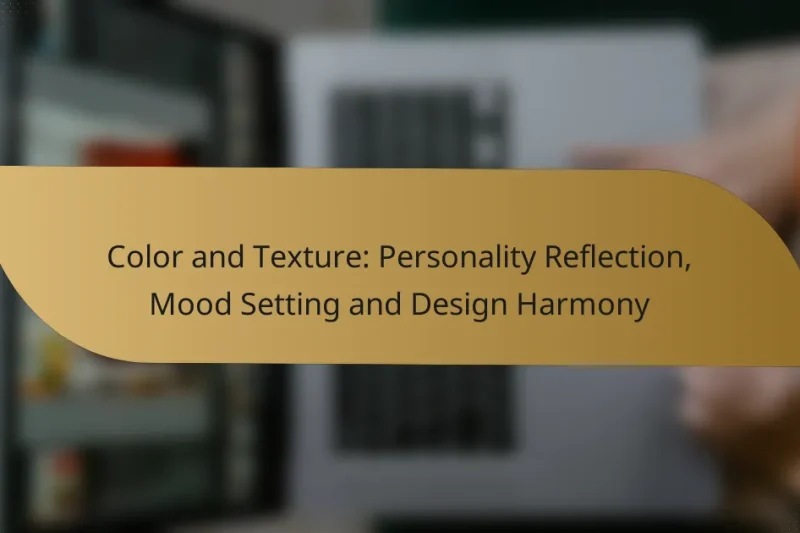A gallery wall is a fantastic way to blend creativity with personal expression, allowing you to … Gallery Wall: Design Ideas, Personalization and Layout TipsRead more
Personalizing Your Home Decor
Personalizing your home decor is an opportunity to showcase your unique style and personality. By selecting colors, unique pieces, and items with sentimental value, you can create a space that truly feels like home. In 2023, trends such as biophilic design and minimalist aesthetics offer fresh inspiration for crafting inviting and personalized environments.
Travel Souvenirs: Incorporation Methods, Display Ideas and Sentimental Value
Travel souvenirs serve as tangible reminders of your adventures, enriching your home with personal stories and … Travel Souvenirs: Incorporation Methods, Display Ideas and Sentimental ValueRead more
Decor Selection: Storytelling Elements, Personal Significance and Style Choices
Choosing decor that embodies storytelling elements can transform your space into a reflection of your personal … Decor Selection: Storytelling Elements, Personal Significance and Style ChoicesRead more
Color and Texture: Personality Reflection, Mood Setting and Design Harmony
Color and texture are powerful tools in design, significantly influencing personality and mood. By understanding how … Color and Texture: Personality Reflection, Mood Setting and Design HarmonyRead more
Family Photos: Display Techniques, Emotional Impact and Aesthetic Appeal
Displaying family photos in your home not only creates a warm and inviting atmosphere but also … Family Photos: Display Techniques, Emotional Impact and Aesthetic AppealRead more
Custom Decor Items: Unique Sources, Online Marketplaces and Trends
Discovering unique custom decor items has never been easier, thanks to a variety of online marketplaces … Custom Decor Items: Unique Sources, Online Marketplaces and TrendsRead more
Personalized Decor for Kids: Themes, Safety and Creative Inspiration
Personalized decor for kids’ rooms not only enhances their space but also reflects their unique interests … Personalized Decor for Kids: Themes, Safety and Creative InspirationRead more
How can I personalize my home decor effectively?
To personalize your home decor effectively, focus on elements that reflect your style and personality. This can be achieved through color choices, unique pieces, and incorporating items with sentimental value.
Use custom color palettes
Choosing a custom color palette is essential for creating a cohesive and personalized look. Start by selecting a few base colors that resonate with you, then add complementary shades to enhance the overall aesthetic. Consider using tools like color wheels or online palette generators to visualize your choices.
When applying your palette, think about different areas of your home. For instance, you might use calming blues and greens in a bedroom while opting for vibrant reds and yellows in a kitchen. This approach allows each space to reflect its intended mood.
Incorporate unique artwork
Unique artwork can serve as a focal point in your home and express your individuality. Look for pieces that resonate with your interests, whether it’s local artists, abstract designs, or photography that captures personal memories. Consider visiting local galleries or online marketplaces for one-of-a-kind finds.
Mixing different styles of artwork can also create visual interest. For example, combine modern prints with vintage frames to add depth to your decor. Remember to consider the scale of the artwork in relation to your wall space to maintain balance.
Select personalized furniture
Personalized furniture can significantly enhance your home’s character. Look for custom-made pieces that fit your specific needs and style, such as a handcrafted dining table or a sofa in a fabric of your choice. This not only ensures a perfect fit but also adds a unique touch to your space.
When selecting furniture, consider multifunctional options that can adapt to your lifestyle, such as ottomans with storage or extendable dining tables. This practicality can help maintain a clutter-free environment while still showcasing your personal taste.
Utilize DIY decor projects
DIY decor projects allow you to create unique pieces that reflect your style while saving money. Start with simple projects like painting old furniture or creating wall art from reclaimed materials. These projects can be both fun and rewarding, giving you a sense of accomplishment.
Consider organizing a DIY night with friends to tackle larger projects together, such as building shelves or creating a gallery wall. This not only makes the process enjoyable but also results in personalized decor that carries memories of the time spent together.
Integrate family heirlooms
Incorporating family heirlooms into your decor adds a rich layer of history and sentimentality. Items like vintage furniture, photographs, or handmade crafts can serve as conversation starters and connect you to your family’s legacy. Display these pieces prominently to honor their significance.
When integrating heirlooms, aim for a balance between old and new. Pairing a vintage piece with modern decor can create a harmonious blend that feels both fresh and nostalgic. Ensure that these items are well-maintained to preserve their beauty and value over time.
What are popular home decor trends in 2023?
In 2023, popular home decor trends include biophilic design, minimalist aesthetics, and vintage styles. These trends emphasize natural elements, simplicity, and nostalgic charm, allowing homeowners to create personalized and inviting spaces.
Biophilic design elements
Biophilic design focuses on incorporating natural elements into home decor to enhance well-being. This can include using plants, natural light, and organic materials like wood and stone. Consider adding indoor plants, large windows, or nature-inspired artwork to create a calming atmosphere.
When implementing biophilic design, aim for a balance between indoor and outdoor spaces. For example, a seamless transition from a living room to a garden can enhance the connection to nature. Additionally, using earthy color palettes can further evoke a sense of tranquility.
Minimalist aesthetics
Minimalist aesthetics prioritize simplicity and functionality, often featuring clean lines and uncluttered spaces. This trend encourages the use of fewer, high-quality items rather than an abundance of decor. To achieve a minimalist look, focus on essential furniture pieces and neutral color schemes.
When decorating with a minimalist approach, consider multi-functional furniture, such as a coffee table with storage. This not only saves space but also maintains a tidy environment. Avoid excessive decorations; instead, choose a few statement pieces that reflect your personality.
Vintage and retro styles
Vintage and retro styles bring a sense of nostalgia and character to home decor. This trend often incorporates items from past decades, such as mid-century modern furniture or antique accessories. Mixing these elements with contemporary designs can create a unique and personalized space.
To effectively use vintage decor, consider visiting thrift stores or flea markets for one-of-a-kind finds. Pairing vintage items with modern furniture can create an eclectic look that feels both fresh and timeless. Remember to maintain a cohesive color scheme to avoid a disjointed appearance.
How do I choose the right decor for my space?
Choosing the right decor for your space involves understanding its size, your personal style, and the lighting conditions. These factors will help you create a cohesive and inviting environment that reflects your personality and meets your functional needs.
Assess room size and layout
Start by measuring the dimensions of your room and noting the layout. Consider the scale of furniture and decor items; larger pieces can overwhelm a small space, while tiny decor may get lost in a large room. Aim for a balance that complements the room’s proportions.
Use a floor plan to visualize how different arrangements will look. This can help you determine the best placement for furniture and decor, ensuring a functional flow that enhances the space.
Consider personal style preferences
Your personal style should guide your decor choices. Think about the colors, patterns, and themes that resonate with you. Whether you prefer modern minimalism, rustic charm, or eclectic combinations, your decor should reflect your tastes.
Gather inspiration from magazines, websites, or social media platforms. Create a mood board to visualize how different elements can work together, making it easier to select pieces that align with your vision.
Evaluate lighting conditions
Lighting plays a crucial role in how decor is perceived. Assess the natural light available in your space and consider how it changes throughout the day. Rooms with ample sunlight can handle bolder colors, while darker spaces may benefit from lighter shades to create a more open feel.
In addition to natural light, think about artificial lighting options. Layering different types of lighting, such as ambient, task, and accent, can enhance the overall atmosphere and highlight your decor effectively.
What are the best online stores for home decor?
The best online stores for home decor offer a mix of styles, price points, and unique items. Popular choices include Wayfair, West Elm, and Etsy, each catering to different tastes and budgets.
Wayfair for diverse options
Wayfair is known for its extensive selection of home decor items, featuring everything from furniture to decorative accessories. With thousands of products available, shoppers can find styles ranging from traditional to contemporary.
When browsing Wayfair, consider using filters to narrow down your search by category, price, or style. This can save time and help you find exactly what you need without feeling overwhelmed.
West Elm for modern designs
West Elm specializes in modern and stylish home decor, emphasizing clean lines and contemporary aesthetics. Their products often incorporate sustainable materials, appealing to eco-conscious consumers.
Prices at West Elm can be on the higher side, but the quality and design often justify the investment. Look out for seasonal sales or clearance events to snag items at a better price.
Etsy for handmade items
Etsy is a marketplace for unique, handmade, and vintage home decor items. It connects buyers with individual artisans, allowing for personalized and one-of-a-kind pieces that can enhance any space.
When shopping on Etsy, pay attention to seller reviews and shipping times, as these can vary significantly. This platform is ideal for finding custom items, such as personalized wall art or handcrafted furniture.
How can I mix and match decor styles?
Mixing and matching decor styles involves combining different design elements to create a cohesive look. Focus on harmonizing colors, textures, and patterns to achieve a balanced aesthetic that reflects your personal taste.
Identify common color schemes
Start by selecting a color palette that includes a few primary colors and complementary shades. Aim for a mix of warm and cool tones to create depth while ensuring that the colors work well together. For example, pairing navy blue with soft beige can create a sophisticated yet inviting atmosphere.
Consider using a color wheel to find harmonious combinations. Analogous colors, which are next to each other on the wheel, often blend seamlessly, while contrasting colors can add visual interest when used sparingly.
Balance textures and patterns
Incorporate a variety of textures and patterns to add dimension to your decor. Use soft fabrics like velvet or linen alongside harder materials such as wood or metal. This contrast can create a dynamic and inviting space.
When mixing patterns, stick to a common color scheme to maintain unity. For instance, you might pair a floral print with striped cushions, ensuring both share a similar color palette. Limit the number of different patterns to three or four to avoid overwhelming the space.






